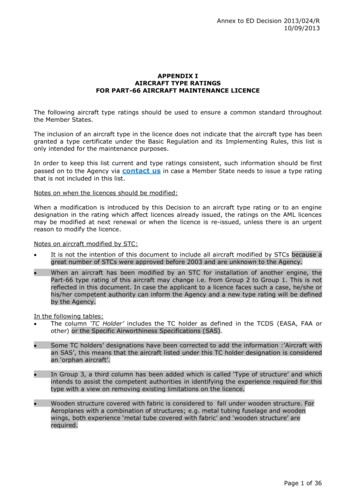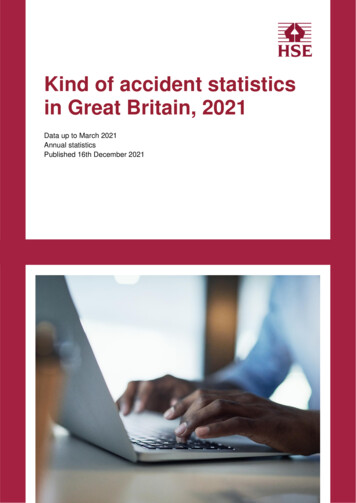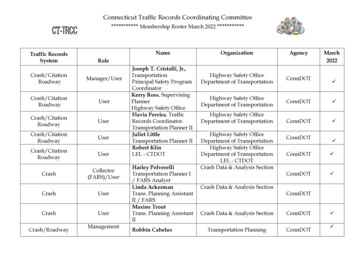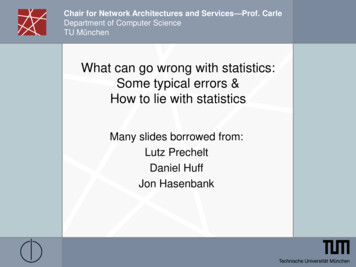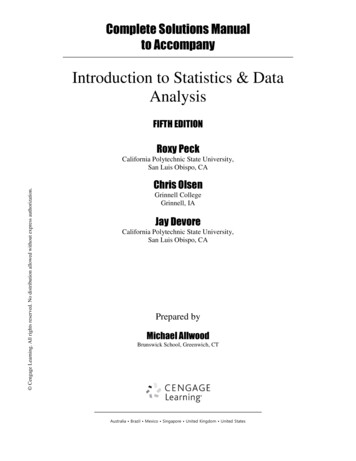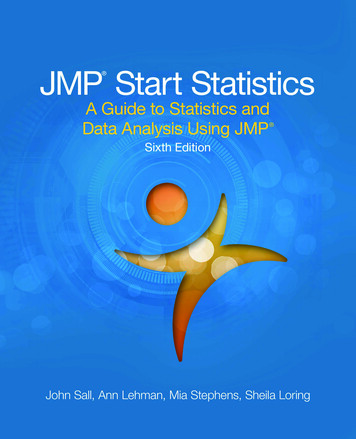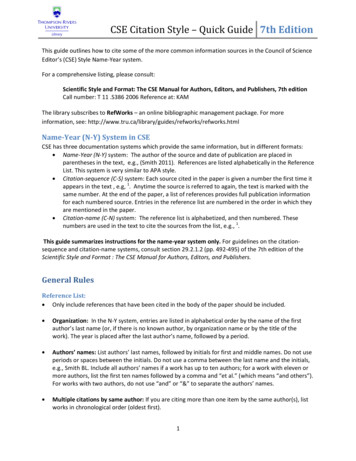
Transcription
Joint Committee on Quantitative Assessment of ResearchCitation StatisticsA report from the International Mathematical Union (IMU) incooperation with the International Council of Industrial andApplied Mathematics (ICIAM) and the Institute of MathematicalStatistics (IMS)Corrected version,6/12/08Robert Adler, John Ewing (Chair), Peter Taylor6/11/2008
June 2008Citation StatisticsIMU‐ICIAM‐IMSExecutive SummaryThis is a report about the use and misuse of citation data in the assessment of scientific research. Theidea that research assessment must be done using "simple and objective" methods is increasinglyprevalent today. The "simple and objective" methods are broadly interpreted as bibliometrics, that is,citation data and the statistics derived from them. There is a belief that citation statistics are inherentlymore accurate because they substitute simple numbers for complex judgments, and hence overcomethe possible subjectivity of peer review. But this belief is unfounded. Relying on statistics is not more accurate when the statistics are improperly used. Indeed,statistics can mislead when they are misapplied or misunderstood. Much of modernbibliometrics seems to rely on experience and intuition about the interpretation and validity ofcitation statistics.While numbers appear to be "objective", their objectivity can be illusory. The meaning of acitation can be even more subjective than peer review. Because this subjectivity is less obviousfor citations, those who use citation data are less likely to understand their limitations.The sole reliance on citation data provides at best an incomplete and often shallowunderstanding of research—an understanding that is valid only when reinforced by otherjudgments. Numbers are not inherently superior to sound judgments.Using citation data to assess research ultimately means using citation‐based statistics to rank things—journals, papers, people, programs, and disciplines. The statistical tools used to rank these things areoften misunderstood and misused. For journals, the impact factor is most often used for ranking. This is a simple average derivedfrom the distribution of citations for a collection of articles in the journal. The average capturesonly a small amount of information about that distribution, and it is a rather crude statistic. Inaddition, there are many confounding factors when judging journals by citations, and anycomparison of journals requires caution when using impact factors. Using the impact factoralone to judge a journal is like using weight alone to judge a person's health.For papers, instead of relying on the actual count of citations to compare individual papers,people frequently substitute the impact factor of the journals in which the papers appear. Theybelieve that higher impact factors must mean higher citation counts. But this is often not thecase! This is a pervasive misuse of statistics that needs to be challenged whenever and whereverit occurs.For individual scientists, complete citation records can be difficult to compare. As aconsequence, there have been attempts to find simple statistics that capture the full complexityof a scientist's citation record with a single number. The most notable of these is the h‐index,which seems to be gaining in popularity. But even a casual inspection of the h‐index and itsvariants shows that these are naïve attempts to understand complicated citation records. Whilethey capture a small amount of information about the distribution of a scientist's citations, theylose crucial information that is essential for the assessment of research.The validity of statistics such as the impact factor and h‐index is neither well understood nor wellstudied. The connection of these statistics with research quality is sometimes established on the basis of"experience." The justification for relying on them is that they are "readily available." The few studies ofthese statistics that were done focused narrowly on showing a correlation with some other measure ofquality rather than on determining how one can best derive useful information from citation data.2
June 2008Citation StatisticsIMU‐ICIAM‐IMSWe do not dismiss citation statistics as a tool for assessing the quality of research—citation data andstatistics can provide some valuable information. We recognize that assessment must be practical, andfor this reason easily‐derived citation statistics almost surely will be part of the process. But citation dataprovide only a limited and incomplete view of research quality, and the statistics derived from citationdata are sometimes poorly understood and misused. Research is too important to measure its valuewith only a single coarse tool.We hope those involved in assessment will read both the commentary and the details of this report inorder to understand not only the limitations of citation statistics but also how better to use them. If weset high standards for the conduct of science, surely we should set equally high standards for assessingits quality.Joint IMU/ICIAM/IMS‐Committee on Quantitative Assessment of ResearchRobert Adler, Technion–Israel Institute of TechnologyJohn Ewing (Chair), American Mathematical SocietyPeter Taylor, University of MelbourneFrom the committee chargeThe drive towards more transparency andaccountability in the academic world hascreated a "culture of numbers" in whichinstitutions and individuals believe that fairdecisions can be reached by algorithmicevaluation of some statistical data; unableto measure quality (the ultimate goal),decision‐makers replace quality by numbersthat they can measure. This trend calls forcomment from those who professionally“deal with numbers”— mathematicians andstatisticians.3
June 2008Citation StatisticsIMU‐ICIAM‐IMSIntroductionScientific research is important. Research underlies much progress in our modern world and provideshope that we can solve some of the seemingly intractable problems facing humankind, from theenvironment to our expanding population. Because of this, governments and institutions around theworld provide considerable financial support for scientific research. Naturally, they want to know theirmoney is being invested wisely; they want to assess the quality of the research for which they pay inorder to make informed decisions about future investments.This much isn't new: People have been assessing research for many years. What is new, however, is thenotion that good assessment must be "simple and objective," and that this can be achieved by relyingprimarily on metrics (statistics) derived from citation data rather than a variety of methods, includingjudgments by scientists themselves. The opening paragraph from a recent report states this view starkly:It is the Government’s intention that the current method for determining the quality ofuniversity research—the UK Research Assessment Exercise (RAE)—should be replaced after thenext cycle is completed in 2008. Metrics, rather than peer‐review, will be the focus of the newsystem and it is expected that bibliometrics (using counts of journal articles and their citations)will be a central quality index in this system. [Evidence Report 2007, p. 3]Those who argue for this simple objectivity believe that research is too important to rely on subjectivejudgments. They believe citation‐based metrics bring clarity to the ranking process and eliminateambiguities inherent in other forms of assessment. They believe that carefully chosen metrics areindependent and free of bias. Most of all, they believe such metrics allow us to compare all parts of theresearch enterprise—journals, papers, people, programs, and even entire disciplines—simply andeffectively, without the use of subjective peer review.But this faith in the accuracy, independence, and efficacy of metrics is misplaced. First, the accuracy of these metrics is illusory. It is a common maxim that statistics can lie whenthey are improperly used. The misuse of citation statistics is widespread and egregious. In spiteof repeated attempts to warn against such misuse (for example, the misuse of the impactfactor), governments, institutions, and even scientists themselves continue to drawunwarranted or even false conclusions from the misapplication of citation statistics. Second, sole reliance on citation‐based metrics replaces one kind of judgment with another.Instead of subjective peer review one has the subjective interpretation of a citation's meaning.Those who promote exclusive reliance on citation‐based metrics implicitly assume that eachcitation means the same thing about the cited research—its "impact". This is an assumption thatis unproven and quite likely incorrect. Third, while statistics are valuable for understanding the world in which we live, they provideonly a partial understanding. In our modern world, it is sometimes fashionable to assert amystical belief that numerical measurements are superior to other forms of understanding.Those who promote the use of citation statistics as a replacement for a fuller understanding ofresearch implicitly hold such a belief. We not only need to use statistics correctly—we need touse them wisely as well.4
June 2008Citation StatisticsIMU‐ICIAM‐IMSWe do not argue with the effort to evaluate research but rather with the demand that such evaluationsrely predominantly on "simple and objective" citation‐based metrics—a demand that often isinterpreted as requiring easy‐to‐calculate numbers that rank publications or people or programs.Research usually has multiple goals, both short‐term and long, and it is therefore reasonable that itsvalue must be judged by multiple criteria. Mathematicians know that there are many things, both realand abstract, that cannot be simply ordered, in the sense that each two can be compared. Comparisonoften requires a more complicated analysis, which sometimes leaves one undecided about which of twothings is "better". The correct answer to "Which is better?" is sometimes: "It depends!"The plea to use multiple methods to assess the quality ofresearch has been made before (for example [Martin 1996]Research usually has multipleor [Carey‐Cowling‐Taylor 2007]). Publications can be judgedin many ways, not only by citations. Measures of esteemgoals and it is thereforesuch as invitations, membership on editorial boards, andreasonable that its value mustawards often measure quality. In some disciplines and inbe judged by multiple criteria.some countries, grant funding can play a role. And peerreview—the judgment of fellow scientists—is an importantcomponent of assessment. (We should not discard peerreview merely because it is sometimes flawed by bias, any more than we should discard citationstatistics because they are sometimes flawed by misuse.) This is a small sample of the multiple ways inwhich assessment can be done. There are many avenues to good assessment, and their relativeimportance varies among disciplines. In spite of this, "objective" citation‐based statistics repeatedlybecome the preferred method for assessment. The lure of a simple process and simple numbers(preferably a single number) seems to overcome common sense and good judgment.This report is written by mathematical scientists to address the misuse of statistics in assessing scientificresearch. Of course, this misuse is sometimes directed towards the discipline of mathematics itself, andthat is one of the reasons for writing this report. The special citation culture of mathematics, with lowcitation counts for journals, papers, and authors, makes it especially vulnerable to the abuse of citationstatistics. We believe, however, that all scientists, as well as the general public, should be anxious to usesound scientific methods when assessing research.Some in the scientific community would dispense with citation statistics altogether in a cynical reactionto past abuse, but doing so would mean discarding a valuable tool. Citation‐based statistics can play arole in the assessment of research, provided they are used properly, interpreted with caution, and makeup only part of the process. Citations provide information about journals, papers, and people. We don'twant to hide that information; we want to illuminate it.That is the purpose of this report. The first three sections address the ways in which citation data can beused (and misused) to evaluate journals, papers, and people. The next section discusses the variedmeanings of citations and the consequent limitations on citation‐based statistics. The last sectioncounsels about the wise use of statistics and urges that assessments temper the use of citation statisticswith other judgments, even though it makes assessments less simple."Everything should be made as simple as possible, but not simpler, " Albert Einstein once said.1 Thisadvice from one of the world's preeminent scientists is especially apt when assessing scientific research.5
June 2008Citation StatisticsIMU‐ICIAM‐IMSRanking journals: The impact factor 2The impact factor was created in the 1960s as a way to measure the value of journals by calculating theaverage number of citations per article over a specific period of time. [Garfield 2005] The average iscomputed from data gathered by Thomson Scientific (previously called the Institute for ScientificInformation), which publishes Journal Citation Reports. Thomson Scientific extracts references frommore than 9,000 journals, adding information about each article and its references to its database eachyear. [THOMSON: SELECTION] Using that information, one can count how often a particular article iscited by subsequent articles that are published in the collection of indexed journals. (We note thatThomson Scientific indexes less than half the mathematics journals covered by Mathematical Reviewsand Zentralblatt, the two major reviewing journals in mathematics. 3 )For a particular journal and year, the journal impact factor is computed by calculating the averagenumber of citations to articles in the journal during the preceding two years from all articles published inthat given year (in the particular collection of journals indexed by Thomson Scientific). If the impactfactor of a journal is 1.5 in 2007, it means that on average articles published during 2005 and 2006 werecited 1.5 times by articles in the collection of all indexed journals published in 2007.Thomson Scientific itself uses the impact factor as one factor in selecting which journals to index.[THOMSON: SELECTION] On the other hand, Thomson promotes the use of the impact factor moregenerally to compare journals."As a tool for management of library journal collections, the impact factor supplies the libraryadministrator with information about journals already in the collection and journals underconsideration for acquisition. These data must also be combined with cost and circulation datato make rational decisions about purchases of journals. "[THOMSON: IMPACT FACTOR]Many writers have pointed out that one should not judge the academic worth of a journal using citationdata alone, and the present authors very much agree. In addition to this general observation, the impactfactor has been criticized for other reasons as well. (See [Seglen 1997], [Amin‐Mabe 2000],[Monastersky 2005], [Ewing 2006], [Adler 2007], and [Hall 2007].)(i) The identification of the impact factor as an average is not quite correct. Because many journalspublish non‐substantive items such as letters or editorials, which are seldom cited, these items are notcounted in the denominator of the impact factor. On the other hand, while infrequent, these items aresometimes cited, and these citations are counted in the numerator. The impact factor is therefore notquite the average citations per article. When journals publish a large number of such "non‐substantial"items, this deviation can be significant. In many areas, including mathematics, this deviation is minimal.(ii) The two‐year period used in defining the impact factor was intended to make the statistic current.[Garfield 2005] For some fields, such as bio‐medical sciences, this is appropriate because most publishedarticles receive most of their citations soon after publication. In other fields, such as mathematics, mostcitations occur beyond the two‐year period. Examining a collection of more than 3 million recentcitations in mathematics journals (the Math Reviews Citation database) one sees that roughly 90% ofcitations to a journal fall outside this 2‐year window. Consequently, the impact factor is based on a mere10% of the citation activity and misses the vast majority of citations. 46
June 2008Citation StatisticsIMU‐ICIAM‐IMSCitation CurvesPercent of 2003 citations14%12%ImpactFactor10%Cell Biology8%Education6%Economics4%Mathematics2%0%2003 2002 2001 2000 1999 1998 1997 1996 1995 1994A graph showing the age of citations from articles published in 2003 covering four different fields.Citations to article published in 2001‐2002 are those contributing to the impact factor; all othercitations are irrelevant to the impact factor. Data from Thomson Scientific.Does the two‐year interval mean the impact factor is misleading? For mathematics journals the evidenceis equivocal. Thomson Scientific computes 5‐year impact factors, which it points out correlate well withthe usual (2‐year) impact factors. [Garfield 1998] Using the Math Reviews citation database, one cancompute "impact factors" (that is, average citations per article) for a collection of the 100 most citedmathematics journals using periods of 2, 5, and 10 years. The chart below shows that 5‐ and 10‐yearimpact factors generally track the 2‐year impact factor.Top 100 Mathematics Journals3"Impact ct factors" for 2, 5, and 10 years for 100 mathematics journals. Data from MathReviews citation database.The one large outlier is a journal that did not publish papers during part of this time; the smaller outlierstend to be journals that publish a relatively small number of papers each year, and the chart merelyreflects the normal variability in impact factors for such journals. It is apparent that changing the7
June 2008Citation StatisticsIMU‐ICIAM‐IMSnumber of "target years" when calculating the impact factor changes the ranking of journals, but thechanges are generally modest, except for small journals, where impact factors also vary when changingthe "source year" (see below).(iii) The impact factor varies considerably among disciplines. [Amin‐Mabe 2000] Part of this differencestems from the observation (ii): If in some disciplines many citations occur outside the two‐yearwindow, impact factors for journals will be far lower. On the other hand, part of the difference is simplythat the citation cultures differ from discipline to discipline, and scientists will cite papers at differentrates and for different reasons. (We elaborate on this observation later because the meaning of citationsis extremely important.) It follows that one cannot in any meaningful way compare two journals indifferent disciplines using impact factors.Average citations per articleMathematics/ComputerSocial scienceMaterials scienceBiological sciencesEnvironmental sciencesEarth SciencesChemistryPhysicsPharmacologyClinical MedicineNeuroscienceLife sciences01234567CitationsAverage citations per article for different disciplines, showing that citationpractices differ markedly. Data from Thomson Scientific [Amin‐Mabe 2000].(iv) The impact factor can vary considerably from year to year, and the variation tends to be larger forsmaller journals. [Amin‐Mabe 2000] For journals publishing fewer than 50 articles, for example, theaverage change in the impact factor from 2002 to 2003 was nearly 50%. This is wholly expected, ofcourse, because the sample size for small journals is small. On the other hand, one often comparesjournals for a fixed year, without taking into account the higher variation for small journals.(v) Journals that publish articles in languages other than English will likely receive fewer citationsbecause a large portion of the scientific community cannot (or do not) read them. And the type ofjournal, rather than the quality alone, may influence the impact factor. Journals that publish reviewarticles, for example, will often receive far more citations than journals that do not, and therefore havehigher (sometimes, substantially higher) impact factors. [Amin‐Mabe 2000]8
June 2008Citation StatisticsIMU‐ICIAM‐IMS(vi) The most important criticism of the impact factor is that its meaning is not well understood. Whenusing the impact factor to compare two journals, there is no a priori model that defines what it means tobe "better". The only model derives from the impact factor itself—a larger impact factor means a betterjournal. In the classical statistical paradigm, one defines a model, formulates a hypothesis (of nodifference), and then finds a statistic, which depending on its values allows one to accept or reject thehypothesis. Deriving information (and possibly a model) from the data itself is a legitimate approach tostatistical analysis, but in this case it is not clear what information has been derived. How does theimpact factor measure quality? Is it the best statistic to measure quality? What precisely does itmeasure? (Our later discussion about the meaning of citations is relevant here.) Remarkably little isknown about a model for journal quality or how it might relate to the impact factor.The above six criticisms of the impact factor are all valid, but they mean only that the impact factor iscrude, not useless. For example, the impact factor can be used as a starting point in ranking journals ingroups by using impact factors initially to define the groups and then employing other criteria to refinethe ranking and verify that the groups make sense. But using the impact factor to evaluate journalsrequires caution. The impact factor cannot be used to compare journals across disciplines, for example,and one must look closely at the type of journals when using the impact factor to rank them. One shouldalso pay close attention to annual variations, especially for smaller journals, and understand that smalldifferences may be purely random phenomena. And it is important to recognize that the impact factormay not accurately reflect the full range of citation activity in some disciplines, both because not alljournals are indexed and because the time period is too short. Other statistics based on longer periodsof time and more journals may be better indicators of quality. Finally, citations are only one way tojudge journals, and should be supplemented with other information (the central message of this report).These are all cautions similar to those one would make for any ranking based on statistics. Mindlesslyranking journals according to impact factors for a particular year is a misuse of statistics. To its credit,Thomson Scientific agrees with this statement and (gently) cautions those who use the impact factorabout these things."Thomson Scientific does not depend on the impact factor alone in assessing the usefulness of ajournal, and neither should anyone else. The impact factor should not be used without carefulattention to the many phenomena that influence citation rates, as for example the averagenumber of references cited in the average article. The impact factor should be used withinformed peer review. " [THOMSON: IMPACT FACTOR]Unfortunately, this advice is too often ignored.Ranking papersThe impact factor and similar citation‐based statistics can be misused when ranking journals, but there isa more fundamental and more insidious misuse: Using the impact factor to compare individual papers,people, programs, or even disciplines. This is a growing problem that extends across many nations andmany disciplines, made worse by recent national research assessments.In a sense, this is not a new phenomenon. Scientists are often called upo
First, the accuracy of these metrics is illusory. It is a common maxim that statistics can lie when they are improperly used. The misuse of citation statistics is widespread and egregious. In spite of repeated attempts to warn against such misuse (for example, the misuse of the impact
